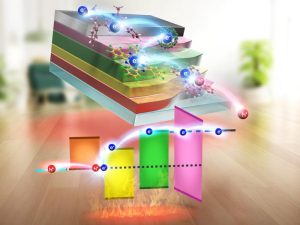Until now, thermoelectric devices have been difficult to exploit fully. However, a new organic thermoelectric device converts room temperature heat into usable electrical energy. No temperature gradient is needed because the team takes advantage of the unique characteristics of the organic materials.
Thermoelectric devices are a series of energy-generating materials that convert heat into electricity so long as there is a temperature gradient—where one side of the device is hot and the other is cool. Because no cooling unit is necessary, the resulting device can be smaller than the current designs.
“We were investigating ways to make a thermoelectric device that could harvest energy from ambient temperature. Our lab focuses on the utility and application of organic compounds, and many organic compounds have unique properties where they can easily transfer energy between each other,” said Professor Chihaya Adachi of Kyushu University’s Center for Organic Photonics and Electronics Research (OPERA). “A good example of the power of organic compounds can be found in OLEDs or organic solar cells.”
The most well-known use of thermoelectric generators is in space probes such as the Mars Curiosity rover or the Voyager probe, powered by radioisotope thermoelectric generators. The heat generated from radioactive isotopes provides the temperature gradient for the thermoelectric devices to power their instruments. However, high production costs, use of hazardous materials, low energy efficiency, and the necessity for relatively high temperatures cause thermoelectric devices to remain underutilized. After testing various materials, the team found two viable compounds: copper phthalocyanine (CuPc) and copper hexadecafluoro phthalocyanine (F16CuPc).

Credit: Kyushu University/Chihaya Adachi
“To improve the thermoelectric property of this new interface, we also incorporated fullerenes and BCP,” continues Adachi. “These are known to be good facilitators of electron transport. Adding these compounds together significantly enhanced the device’s power. In the end, we had an optimized device with a 180 nm layer of CuPc, 320 nm of F16CuPc, 20 nm of fullerene, and 20 nm of BCP.”
The optimized device had an open-circuit voltage of 384 mV, a short-circuit current density of 1.1 μA/cm2, and a maximum output of 94 nW/cm2. Moreover, all of these results were achieved at room temperature without using a temperature gradient.
The team published its findings in the journal Nature Communications.

